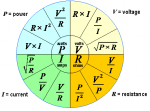ok, tutors, i've been studying what you told me.
some stuff, i think i get.
amps is just rate of electron flow n the rate coming from the battery must be the same as that coming back.
that makes no sense, but i take your word fort it.
now, volts is the number of electrons passing in the current.,
multiplying them gives me watts.
ok, fine.
but what is the mod regulating to give me the watts i want?
is it adjusting volts or amps?
some stuff, i think i get.
amps is just rate of electron flow n the rate coming from the battery must be the same as that coming back.
that makes no sense, but i take your word fort it.
now, volts is the number of electrons passing in the current.,
multiplying them gives me watts.
ok, fine.
but what is the mod regulating to give me the watts i want?
is it adjusting volts or amps?


